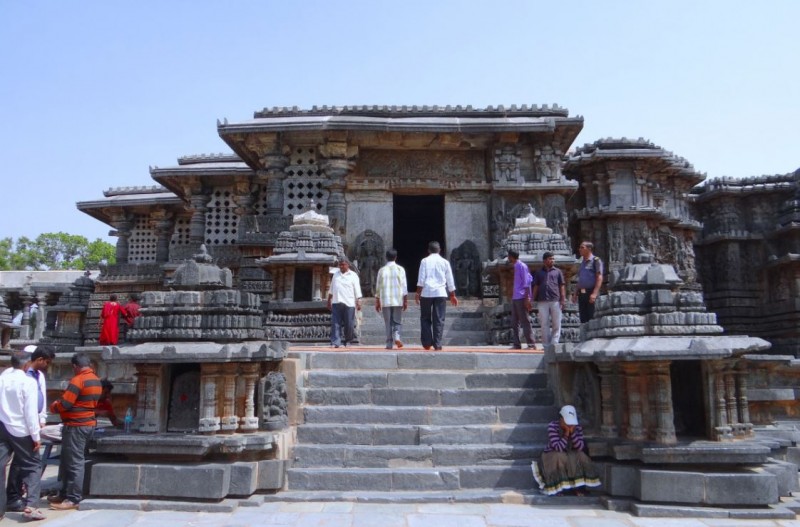
Hindu temples in India showcase a remarkable diversity of architectural styles that span centuries of history and cultural influences. These sacred structures not only serve as places of worship but also stand as magnificent testaments to the craftsmanship and artistic brilliance of ancient Indian civilizations. From the towering spires of the Dravidian style in the south to the intricate carvings of the Nagara style in the north, each architectural tradition tells a unique story. In this article, we will explore the fascinating world of Hindu temple architecture and delve into the various styles found across India.
Dravidian Style
The Dravidian style of temple architecture is primarily found in the southern regions of India, including the states of Tamil Nadu, Karnataka, Kerala, and Andhra Pradesh. This style is known for its towering gopurams (entrance gateways) adorned with intricate sculptures and elaborate carvings. The temples are often enclosed within rectangular compounds and feature a central sanctum housing the deity.
Prominent examples of Dravidian style temples include the Brihadeeswarar Temple in Thanjavur, Tamil Nadu, and the Meenakshi Temple in Madurai. These temples are characterized by their pyramid-shaped vimanas (towering structures above the sanctum) and ornate pillars.
Nagara Style
The Nagara style of temple architecture is prevalent in the northern and central regions of India, particularly in states like Rajasthan, Madhya Pradesh, and Gujarat. This style is characterized by its curvilinear spires called shikharas, which rise in a stepped manner. The temples are usually built on a raised platform and have a mandapa (assembly hall) preceding the sanctum.
Famous examples of Nagara style temples include the Kandariya Mahadeva Temple in Khajuraho, Madhya Pradesh, and the Sun Temple in Konark, Odisha. These temples showcase intricate carvings of gods, goddesses, and celestial beings on the outer walls, depicting mythological stories and everyday life scenes.
Vesara Style
The Vesara style of temple architecture is a fusion of the Dravidian and Nagara styles, predominantly seen in the Deccan region of India. This style combines the gopuram of the Dravidian style with the shikhara of the Nagara style. The temples in this style often have multiple sanctums and exhibit a blend of ornate and simple architectural elements.
One of the notable examples of the Vesara style is the Hoysaleswara Temple in Halebidu, Karnataka. It showcases intricate carvings and sculptures depicting scenes from Hindu mythology, along with a unique interplay of light and shadow.
Kalinga Style
The Kalinga style of temple architecture is prominent in the eastern state of Odisha. This style is characterized by its unique shape called the Rekha Deula, which consists of a sanctum, a porch, and a spire. The spire is usually adorned with miniature replicas of itself, creating an impressive visual effect.
The Jagannath Temple in Puri, Odisha, is a prime example of the Kalinga style. It is renowned for its Rath Yatra festival and the intricate carvings on the temple walls, depicting various episodes from the Hindu epics.
Maru-Gurjara Style
The Maru-Gurjara style of temple architecture originated in the western Indian state of Gujarat and Rajasthan. This style exhibits a unique blend of Nagara and Vesara styles, characterized by intricate carvings, domes, and intricate architectural details. The temples are often built with white marble, creating a sense of grandeur.
The Dilwara Temples in Mount Abu, Rajasthan, are exquisite examples of the Maru-Gurjara style. They are renowned for their intricate marble carvings, delicate ceilings, and ornate doorways.
Hindu temples across India showcase a rich tapestry of architectural styles, each with its own distinct features and influences. The Dravidian, Nagara, Vesara, Kalinga, and Maru-Gurjara styles exemplify the remarkable diversity of Indian temple architecture. These temples stand as living heritage, carrying forward centuries of cultural, spiritual, and artistic traditions.
Some special things about the 150-foot-long and 25-foot-wide statue of Adiyogi
Decoding the DNA of Indian Politics: A Historical Perspective
Kerala Devotees Engage in KARKIDAKA VAVU BALI Ritual Statewide